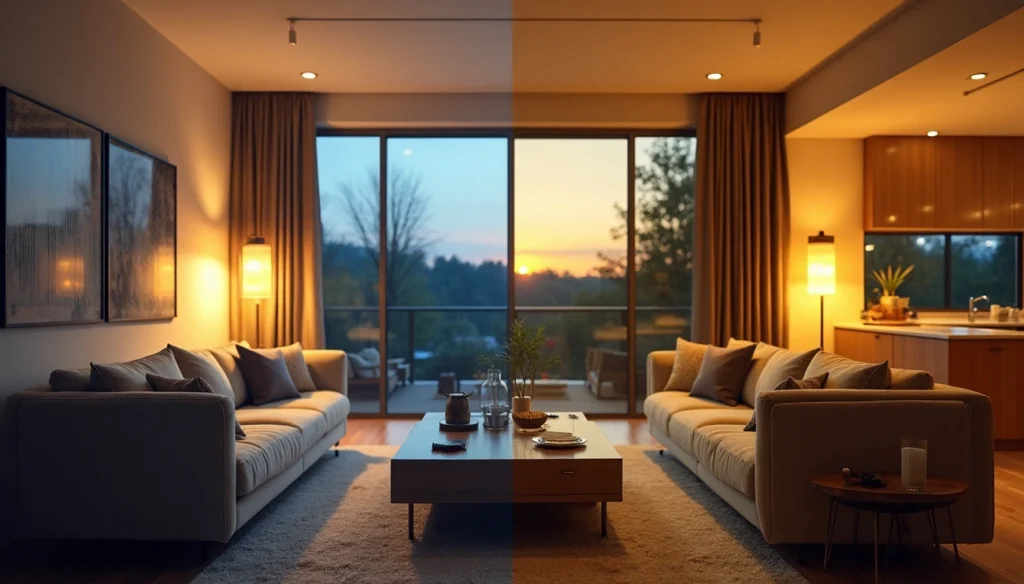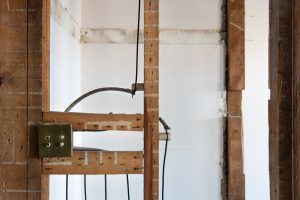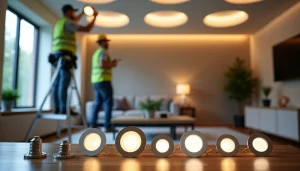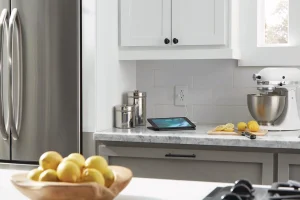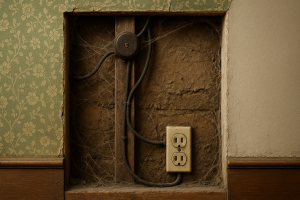Your home’s electricity use could drop by 15% with energy-efficient lighting, putting about $225 back in your pocket each year. Most homes still use old lighting – all but one of these households have at least one incandescent bulb.
Global energy stats paint an interesting picture. Lighting makes up 13% of worldwide energy use and adds 5% to our total carbon emissions yearly. Making a switch to efficient lighting makes both environmental and financial sense. Modern efficient bulbs last 25 times longer than old ones and use 75% less power. Your home’s energy use can drop by 80% with smart lighting choices throughout.
Learning about the most efficient lighting options for your home will help you boost both function and mood while shrinking your carbon footprint. Today’s options are a great way to get convenience and savings. Smart systems let you control lights remotely, while dimmers and timers handle usage automatically. This piece shows you the quickest way to light up each room without breaking the bank.
Why Energy-Efficient Lighting Matters
U.S. commercial buildings use about 17% of their electricity for lighting, while an average home uses 15%. Switching to energy-efficient lighting is one of the quickest and budget-friendly ways to cut down energy use and help the environment.
Lower energy bills and long-term savings
The money you save with energy-efficient lighting goes way beyond the original purchase price. LED lighting, today’s most advanced option, cuts energy use by up to 90% compared to old incandescent bulbs. These savings show up right away on your utility bills—households save about $225 yearly just by using LED lights.
The long-term math makes sense. LEDs cost more upfront but last 25 times longer than incandescent bulbs. You won’t need to replace them often, which saves on maintenance costs. Businesses save even more—lighting can take up 20-40% of a city’s electricity bill. Los Angeles saves $10 million each year on electricity and another $3 million on maintenance after switching to LEDs.
The time it takes to recover your investment in energy-efficient lighting is short. The Electric Power Research Institute found that most lighting updates pay for themselves through energy savings in less than seven years. Some projects break even in under three years.
Environmental benefits of reduced carbon footprint
Energy-efficient lighting helps your wallet and the planet. Lighting creates nearly 5% of global CO2 emissions. The world could cut these emissions by more than a third by switching to efficient lighting.
The potential effect is huge. LED technology could save over 1,400 million tons of CO2 and eliminate the need for about 1,250 power plants. U.S. energy savings from LED lighting could reach 569 TWh yearly by 2035. That equals the output of more than 92 large power plants (1,000 MW each).
LED lights are better for the environment than fluorescent bulbs because they don’t contain mercury. You can recycle them completely, which reduces their environmental impact. One LED bulb saves the materials needed to make 25 incandescent bulbs.
Understanding efficient lighting design
You need to know several key concepts to use energy-efficient lighting well:
- Efficacy – Light produced versus energy used, measured in lumens per watt. Higher numbers mean better efficiency.
- Color temperature – Measured in Kelvin (K), this shows how warm or cool the light looks. Most indoor spaces work best with 2700-3600K.
- Color Rendering Index (CRI) – Shows how well colors look under the light (scale 1-100). A CRI of 80 or higher works well in most homes.
Good lighting design uses three main types: ambient lighting for general room light, task lighting for specific activities, and accent lighting to showcase special features. The right mix creates spaces that save energy and look great.
Natural light plays a vital role in efficient design. Windows, skylights, and light-redirecting devices can reduce the need for artificial lighting during the day. Smart controls that adjust light levels based on available daylight help save even more energy.
Living Room Lighting Solutions
Living Room Lighting Solutions
Your living room is the heart of your home—a place to relax, entertain, and spend quality time with family. You need careful planning to create functional and ambient lighting while keeping energy costs down.
Use of dimmable LED downlights
LED downlights make an excellent choice for your main living room lighting. They offer great versatility and efficiency, and can cut your energy use by up to 85% compared to traditional options. Your LED downlights must work with your current dimmer switches, or you might need to upgrade to compatible models.
ENERGY STAR certified downlights provide a list of compatible dimmers to help you choose the right one. You should check the dimmer manufacturer’s website for recommended bulbs if you’re adding new downlights to an existing dimmer. This way, you’ll save energy and set the perfect mood for any occasion.
LED downlights come with several features worth looking into:
- Adjustable color temperature that switches from warm to cool using a bulb switch or smartphone app
- “Warm-dim” technology that makes light warmer as it dims, just like traditional incandescent bulbs
- A long lifespan of at least 35,000 hours
Smart lighting for mood control
Smart lighting systems have changed how we light our living spaces. They give you unprecedented control over your environment. Lighting affects your mood substantially—harsh lights can make you tense, while soft, warm lighting helps you relax.
Smart lighting lets you:
Set brightness levels and color temperatures based on what you’re doing, from watching movies to hosting guests. You can create personal “scenes” for different moods that activate with a voice command or smartphone tap. Research shows that blue-enriched white light during the day boosts alertness and mood levels substantially.
Smart lighting does more than just add convenience. It can mimic natural light patterns and reduce seasonal affective disorder symptoms by up to 50%. You can also control your lights from anywhere, so you’ll never accidentally leave them on when you’re away.
Energy-efficient floor lamps
Floor lamps add style while providing essential extra lighting for your living space. LED floor lamps stand out as efficient options that use 90% less electricity than traditional bulbs. These lamps need just 10-15 watts to match the brightness of a 60-100 watt incandescent bulb.
Your living room needs floor lamps with 60-100 watt equivalent output for ambient lighting. The right placement matters as much as efficiency. Put your lamps in corners and near seating areas to create layers of indirect light that improve the room’s atmosphere.
Today’s energy-efficient floor lamps pack extra features that boost function and style. Many include dimming options and smart connectivity to work with home automation systems. Some models even come with built-in shelves—perfect for smaller living spaces.
A thoughtful mix of dimmable downlights, smart lighting systems, and energy-efficient floor lamps creates an efficient lighting design. This approach makes your living room both functional and beautiful while keeping energy use low. The layered lighting meets all your needs while maintaining great esthetics.
Kitchen and Dining Area Lighting
Kitchen spaces just need smart lighting that balances functionality with energy efficiency. The perfect mix of lighting fixtures improves your cooking experience and cuts down electricity use.
Under-cabinet LED strip lights
Upper cabinets cast dark shadows, making under-cabinet lighting crucial for safe food prep. LED strip lights light up these shadowy spots and create bright workspaces while using minimal power.
Your LED strips for under-cabinet setup should have at least 200 lumens per foot. This ensures enough brightness for tasks. The color temperature makes a big difference—warm white (2700K-3000K) gives you a cozy feel, while cooler temps help you see details better.
You’ll need proper prep for installation:
- Clean cabinet undersides really well with degreasing cleaner and rubbing alcohol
- Get precise measurements of each cabinet section, adding extra length for adjustments
- Check LED strips before installing to make sure they work and have the right color
- A dimmer switch can give you better control over brightness
LED under-cabinet lights make cooking safer and add a warm glow to your kitchen.
Pendant lights for task lighting
Pendant lights are perfect for focused light over islands, sinks, and dining spots. Your island’s size should match the pendant size—big pendants over tiny islands look out of place.
Place your pendants 30 to 32 inches apart and 30 to 36 inches above the counter. This setup prevents light overlap while giving you enough task lighting. An eight-foot island works well with three small-to-medium pendants, while a twelve-foot island can fit five.
LED pendants blend style with substantial energy savings. They give excellent task lighting and use minimal power—perfect for spots where lights stay on for hours.
Recessed lighting for general illumination
Recessed lights fill the gaps in your kitchen’s lighting plan and provide even background light. These ceiling-flush fixtures create a clean look and maximize headroom—especially helpful in smaller kitchens.
Four-inch or 5-inch recessed lights with reflectors focus light effectively over prep areas. Your room’s size and ceiling height should guide your fixture choice—bigger spaces usually need stronger lights.
Energy-saving LED recessed lighting includes modernize kits for existing cans, so you won’t need new fixtures. These LED options give better color rendering and use about 80% less power than regular incandescent bulbs.
Smart placement prevents shadows and patchy lighting. Cross-illumination helps avoid glare on glossy countertops. When combined with under-cabinet and pendant lights, well-placed recessed fixtures create layers of light that boost both function and mood.
Bedroom and Bathroom Lighting Tips
Bedrooms and bathrooms need special lighting that balances energy savings with practical use. These private spaces serve many purposes throughout the day, so adaptable lights are crucial for comfort and utility.
Soft ambient lighting with LED ceiling fixtures
LED ceiling fixtures create a calming atmosphere in bedrooms and help cut energy costs. Modern LED ceiling lights cut energy use by 90% and last 25 times longer than regular incandescent bulbs. The most relaxing setup uses LED ceiling fixtures with color temperatures between 2700K-3000K. These provide a warm, yellowish light that looks like traditional incandescent bulbs.
You can adjust brightness easily with dimmable LED ceiling fixtures based on what you’re doing – bright light to clean, soft light to unwind before bed. Built-in dimmers let you control the room’s mood perfectly. Bedrooms work best with layers of light. The ceiling fixtures provide the main light source while other lamps add extra illumination where needed.
Motion sensor lights for closets and bathrooms
Motion-activated lights are one of the best ways to save energy in spaces you don’t use often. These lights turn on automatically when they detect movement and switch off after 20-30 seconds without activity.
LED motion sensor lights in closets make it easy to find what you need without fumbling for switches in the dark. They also prevent wasted energy from forgotten lights. You can choose between battery-powered wireless units or hardwired options like the Lithonia Lighting LED Motion Sensor Flush Mount Closet Light.
Motion sensors really shine during nighttime bathroom visits. Low-level motion-activated lights provide enough light without being too bright and disrupting sleep. These fixtures create a luxurious feel when installed at floor level, lighting up the floor with a gentle glow that keeps you safe.
Vanity lighting with high CRI LEDs
Good vanity lighting makes a huge difference in grooming tasks. High Color Rendering Index (CRI) LED fixtures rated above 90 show skin tones and colors accurately. This makes them perfect for applying makeup and detailed grooming.
The best way to avoid shadows is to place vanity lights vertically on both sides of the mirror instead of above it. Place these fixtures 36-40 inches apart with their centers at eye level. This setup creates even lighting that eliminates shadows and shows your reflection accurately.
The color temperature you choose affects how well vanity lighting works. Experts suggest warm white to neutral white (2700K-3500K) for bathroom vanities. This range gives flattering light that looks like natural sunlight but stays comfortable for daily use.
Outdoor and Entryway Lighting Ideas
Making your home’s exterior spaces brighter with energy-efficient lighting improves safety and cuts down electricity bills. Well-lit outdoor areas keep intruders away and make paths welcoming for your guests and family.
Solar-powered pathway lights
Solar pathway lights offer the best energy-saving solution for outdoor lighting. These fixtures utilize sunlight through their solar panels and eliminate electricity costs. Quality solar pathway lights run for six to eight hours after a full charge and light up your property reliably throughout the evening.
Brightness levels matter a lot when choosing solar path lighting. You’ll find options from subtle 3-4 lumen decorative lights to powerful 150-200 lumen models that light up main pathways. Lights with larger solar panels work better because they capture more energy during cloudy days and in shaded areas.
These lights are easy to install without any wiring. You just need to stake them into the ground along walkways, driveways, or garden borders. Place them 6-8 feet apart to get consistent lighting without gaps or overlapping light pools.
LED floodlights with motion sensors
Motion-activated LED floodlights provide powerful light right when you need it. These fixtures stay off until they detect movement, then light up large areas with 1000-2000 lumens of bright light. This smart operation saves much more energy than lights that stay on constantly.
Your property stays secure when you install motion sensor floodlights at key spots—garages, side doors, and dark corners. Modern models come with adjustable settings such as:
- Detection range (typically 180-240 degrees)
- Illumination duration (20 seconds to 10 minutes)
- Light sensitivity threshold
- Brightness levels
Foyer lighting with energy-efficient fixtures
Your entryway makes vital first impressions and bridges outdoor and indoor spaces. LED foyer lights use 90% less energy than traditional options while giving excellent brightness.
Smart lighting controls make entryways more efficient. Dimmable fixtures let you adjust brightness based on time of day and your needs. Motion-activated foyer lighting works great too – it turns on automatically when someone walks in and powers down after a set time.
LED fixtures bring style and longevity to your entryway without frequent bulb changes. These lights typically last 25,000-50,000 hours and maintain consistent light quality throughout their lifespan. You’ll spend less time on maintenance and more time enjoying your well-lit space.
Conclusion
Energy-efficient lighting solutions in your home can do much more than lower your utility bills. Each room needs different types of lighting, and you can meet these needs with specialized energy-saving options. LED technology is pioneering this lighting transformation. These bulbs use up to 90% less energy and last 25 times longer than regular ones.
Switching to energy-efficient lighting is one of the easiest ways to reduce your carbon footprint. The financial benefits are impressive too. You could save $225 every year while cutting your home’s electricity use by up to 15%. On top of that, it saves you money over time because you won’t need to replace bulbs or pay for maintenance as often.
Good lighting design needs to balance function and atmosphere. You can customize your lighting based on what you’re doing with dimmable options, smart controls, and motion sensors. The right color temperature and CRI will make your spaces look their best.
You don’t need to renovate your entire home to get better lighting. Start with small changes like under-cabinet LEDs in your kitchen or solar pathway lights outside. You can gradually add more efficient lighting throughout your house. Every upgrade helps you save more while making your living space better.
The future of home lighting looks promising. Advanced LED technology and smart controls are making energy-efficient lighting more affordable and versatile. When you improve your home’s lighting efficiency today, you’ll save money, help the environment, and create beautiful, functional spaces that last for years.
